a policy brief from ICPH
February 2013
Charter schools were introduced to New York City in 1999 to inject new life into the nation’s largest education system. Fourteen years later, the debate over whether these institutions succeed in helping the city’s neediest students remains front and center. While only 4% of New York City’s more than one million students currently attend charter schools, the last several years have seen an exponential increase in the charter-school enrollment of homeless students1: an astounding 1,723% from 2007 to 2010.2 Even though their total number remains small, at just over 2,000 students citywide, such a large and rapid increase cannot be ignored. Little is currently known about how these hardest-to-reach students fit into New York City’s charter-school experiment. Using data from the Basic Educational Data System and its successor, the Student Information Repository System, from school year (SY) 2007–08 through SY 2010–11, this report seeks to provide a snapshot of the charter-school system in New York City and raise important questions about its role in the education of homeless students.
Homeless Students’ Numbers Rise
Meeting the educational needs of homeless students in New York City is not a new challenge, but it is a growing one. With their numbers steadily climbing in the last five years, the need to find innovative ways to do so has become even greater. In 2007 homeless children made up 5% of the student body, at 50,926 students. By 2010 that number had swelled 36%, to 69,244, representing 7% of the total population (see Figure 1).3 This increase comes as no surprise, as the number of homeless families has reached a new record and is likely to keep rising.4
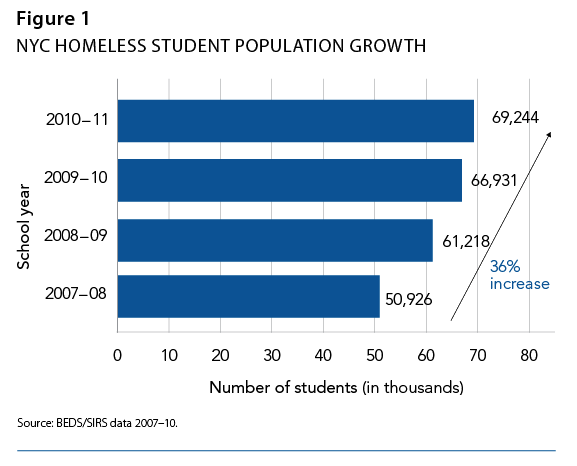
Given the strong link between obtaining a high-school diploma and attaining self-sufficiency in adulthood, ensuring that homeless students receive the best education possible is vital.5 As a transient and often hard-to-identify group, homeless students face many barriers to services that others take for granted. Simply enrolling in a school can be a challenge without necessary documentation or a fixed address, and the instability of daily life greatly increases the likelihood of switching schools multiple times a year and missing many school days, setting back educational attainment.6 In fact, 97% of homeless children have moved at least once in a single year.7
… Homeless children are three times more likely than their housed peers to be placed in special-education programs, four times more likely to drop out of school, eight to nine times more likely to repeat grades, and twice as likely to score poorly on standardized tests in math and reading.
To address these pressing issues, Congress included several provisions designed to support the education of homeless students in the McKinney-Vento Act of 1987, the first and only piece of major federal legislation to focus on homelessness.8 The law ensures that children experiencing homelessness have the same access to education as their peers and guarantees additional supports to allow these children to overcome barriers to education, such as lack of transportation, irregular meals, and difficulties with enrollment.9 It also requires each Local Educational Agency (LEA) to designate a liaison who can assist homeless children and families.10 As public institutions, charter schools are subject to all of the requirements established under the McKinney-Vento Act. Despite those protections, however, homeless children are three times more likely than their housed peers to be placed in special-education programs, four times more likely to drop out of school, eight to nine times more likely to repeat grades, and twice as likely to score poorly on standardized tests in math and reading.
Charter Schools 101
Charter schools are elementary or secondary schools that receive public funding but have been exempted from some of the regulations that govern other public schools. In exchange, they are held accountable for producing certain results as established in each school’s charter.12 Unlike traditional public schools, charters have the ability to sidestep unionized teachers’ collective-bargaining rights, the freedom to lengthen the school day and year as they see fit, and the right to manage their own budgets.
Proponents of charter schools claim that their added flexibility allows greater innovation and opportunity for learning, particularly for those from disadvantaged backgrounds. They also cite better scores on standardized math and reading exams, and better rates of improved scores, for charter-school students than for their traditional-public-school counterparts. Critics, on the other hand, question the level of accountability to which charter schools are held by their authorizing organizations. They also contend that higher scores are a result of “creaming” the most motivated students from district public schools. Both national and local studies of charter-school performance show mixed results. An evaluation of New York City’s charter schools released in 2009 concluded that, on average, students who received charter-school lottery slots showed better test results in math and reading than those students who applied but did not get slots.13
Supply and Demand
Regardless of the open questions surrounding accountability and performance, seats in charter schools remain in high demand. Estimates for SY 2011–12 show a total of 64,390 applications for just 12,917 new seats citywide (see Figure 2).14 The majority submitted applications for schools in Harlem, the South Bronx, or Central Brooklyn. These neighborhoods also contain the greatest number of new seats available to students.15
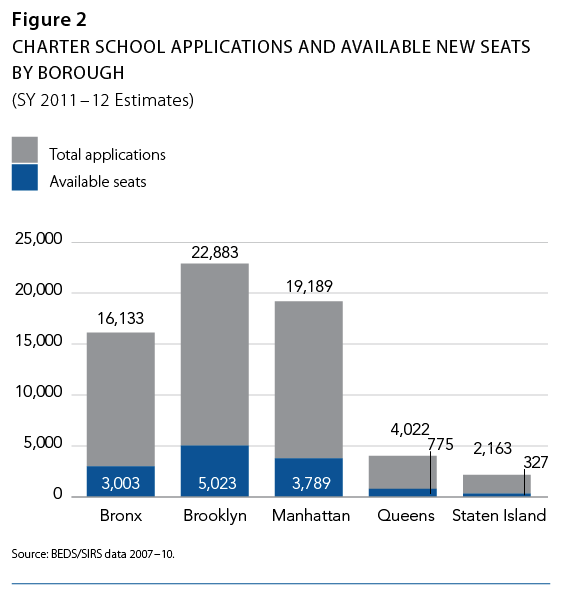
Demand has also led to a rapid increase in the founding of new charter schools. Since 2007 New York City has seen the number in operation double, from 60 in SY 2007–08 to 124 in SY 2010–11 (see Figure 3).16 The majority cater to elementary education. While charter schools still represent a small portion of the total number of schools in New York City, at 8%, up from 4% in 2007, the number is likely to grow, as the push for more charter schools shows no sign of abating.
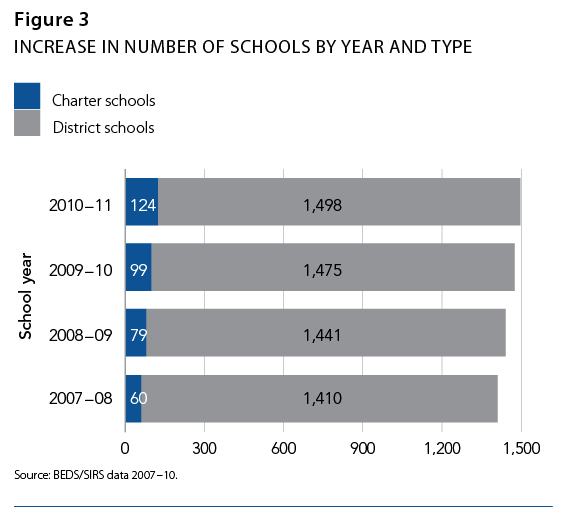
Charter-school openings have not materialized evenly across all five boroughs, however. In 2007 Manhattan led the city in the number of charter schools, with 21 in operation, while Brooklyn was home to 18. Although Manhattan has steadily added charter schools every year, housing 33 in 2010, Brooklyn has surpassed all boroughs. In just four years Brooklyn opened 29 new schools, nearly tripling the number of schools in its environs to a total of 47 (see Figure 4). Queens, on the other hand, has lagged in the creation of charter schools, adding only four in the four-year period.
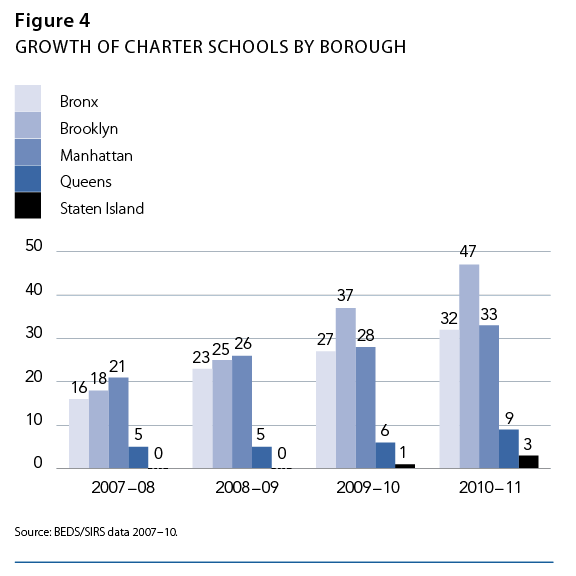
Enrollment of Homeless Students
Although charter schools have succeeded in increasing the enrollment of at-risk populations, it is unclear whether this is a result of a coordinated effort to recruit at-risk students or simply of the appeal of these schools for low-income and minority families with few alternatives.17 Charter schools fill their halls through a lottery-based application system overseen by the schools themselves. The application requires little information, but even providing a contact address can prove difficult for a transient family. Prior to 2007 homeless students were poorly represented in charter schools. In SY 2007–08, they made up only 0.5% of the population of those institutions while constituting 5% of the student body in district schools. From 2007 to 2010, however, the number of homeless students in charter schools shot up to 2,023 from 111, a 1,723% increase (see Figure 5).18 In four years, the proportion of homeless students in charters has only begun to approach parity with that of the districts.
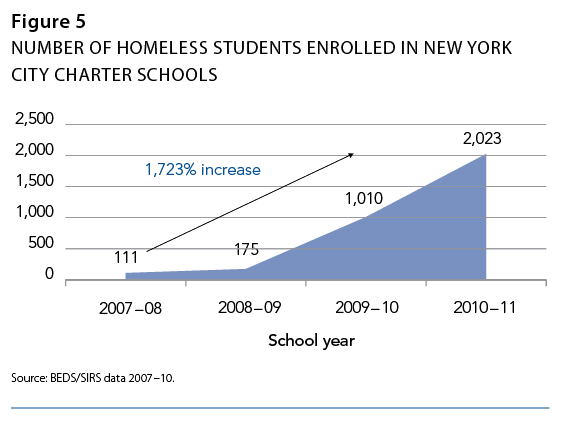
Increases in the enrollment of homeless students in charter schools are particularly revealing when separated by city borough. Before 2007 they were largely educated in schools in Manhattan and the Bronx, with 89% of all homeless students in charters attending schools in those two boroughs. Between 2007 and 2010, however, Brooklyn saw a near-tripling in the total number of homeless students enrolled (see Figures 6 and 7)19, supplanting the Bronx by SY 2010–11 as the borough with the second-largest population, behind Manhattan.
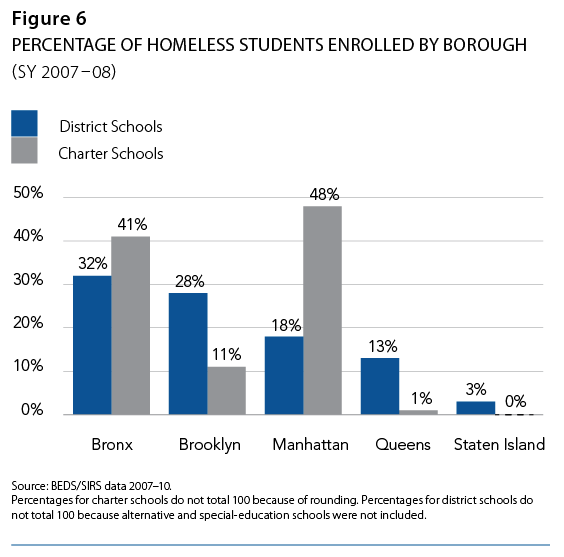
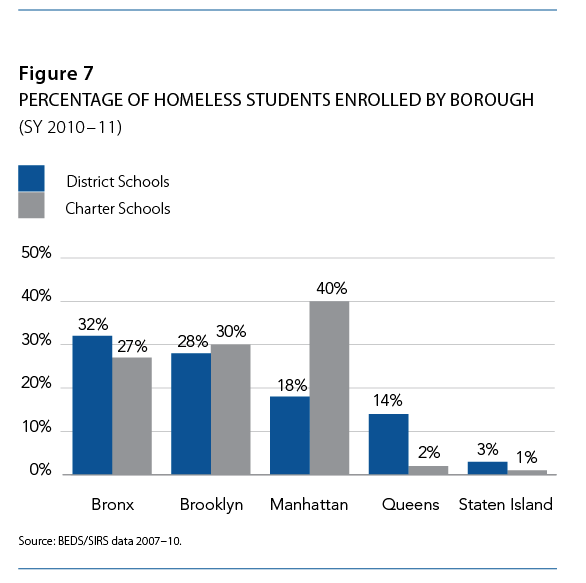
Despite the growth in the enrollment of homeless students in charter schools, disparities with district schools persist. Homeless students remain a larger part of the student body in district schools than in charter schools, though the gap has narrowed in Manhattan and Brooklyn. In the Bronx, for example, 10.6% of the student body in district schools experienced homelessness in SY 2010–11, compared with 5.5% in charters (see Figure 8)20. While Staten Island remains the lone borough where charter schools surpass their district counterparts in homeless-student enrollment as a proportion of total enrollment, the number of students enrolled in charter schools there is too small to make meaningful comparisons. Overall, homeless students continue to be underrepresented in charter schools in comparison with their district peers.
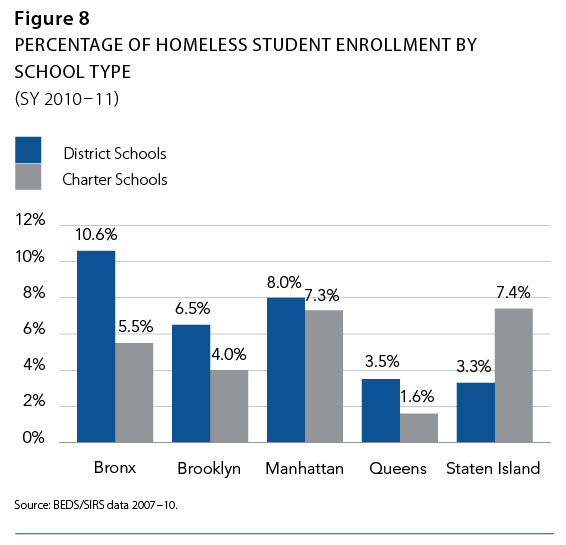
Unanswered Questions
To fully evaluate the long-term effects of charter schools on homeless students, more data must be gathered and more questions must be answered. Before making decisions to expand programs that have not as yet proven to be qualitatively better or more cost-effective than their traditional-school counterparts, school districts and policymakers should examine the following to accurately assess the educational value of charter schools in their neighborhoods and their ability to serve and retain homeless students.
School Performance
Gauging school performance remains difficult, as official appraisals of many charter schools are either incomplete or unavailable. Charter schools that have operated less than two or three years, are still adding grade levels, or have yet to graduate classes are not given progress-report grades, the standard by which all city schools are compared. More than a quarter (28%) of New York City’s charter schools did not receive grades in SY 2010–11. Until charter schools are consistently and accurately evaluated, families will remain severely limited in their ability to make meaningful comparisons and informed decisions about the education choices for their children.21
Funding Disparities
Charter schools that are housed in city-operated buildings, representing two-thirds of all charters, received $649 more per student than traditional public schools during SY 2009–10 (see Figure 9).22 In 2011, 102 of the city’s 124 charter schools (or 82%) were in Department of Education buildings. The Independent Budget Office estimates that the funding gap between traditional and charter schools widened in the 2010–11 school year. Given the lack of clear evidence that they do a better job of educating youth, providing more funding to charter schools could unnecessarily undermine the viability of the traditional public schools that share the same city-owned spaces.
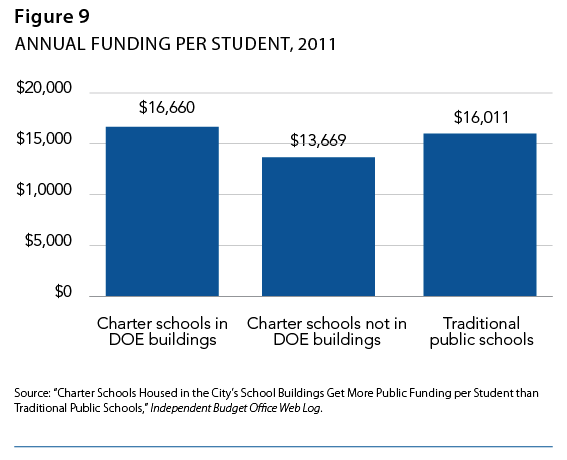
Application Process
While enrollment in charter schools has increased overall among homeless students, there remains a concern that only the most motivated homeless families are likely to successfully manage the application process. A memorandum issued by the New York State Department of Education in July 2010 granted homeless students additional flexibility in the admissions process, which requires schools to give preference to students living in their districts. With homeless students allowed to list multiple previous residences for the purposes of tracking school attendance, they have a greater selection of schools to choose from than other students, which can ensure both greater stability and opportunity in their education.23 However, it is unknown how many of these families are taking advantage of their expanded residency preference.
Outreach for Enrollment
The common criticism that charter schools educate smaller percentages of at-risk students than district schools seems to have merit, as less than 4% of charter schools in SY 2010–11 took measures to enroll students in temporary housing in their programs.24 Charter schools have also reported very low rates of targeted outreach to other at-risk populations, such as English Language Learners, foster children, and special-needs children. When coupled with the fact that homeless students are underrepresented in charter schools, these data make it difficult for those schools to challenge allegations of creaming students for better performance and raise serious questions about exactly who potentially benefits from a charter-school education.
These statistics are likely to be scrutinized in the near future, as policy changes have placed an increased focus on balancing enrollment. In May 2010 the New York State Department of Education updated its Charter Schools Act Amendment of 1998, requiring that any charter school make “good faith” efforts to enroll and retain English Language Learners, students with disabilities, and low-income students at the same rate as the traditional public schools in the same district.25 As this change occurred after the application window for SY 2010–11 had passed, the latest data available do not reflect its impact on enrollment levels.26 If the measure has been successful, charters’ proportional enrollment of difficult-to-serve populations should become apparent at the end of SY 2012–13. After this point, more data will be needed to know if charter schools are building the capacity required to provide for the scholastic needs of English Language Learners, low-income children, and particularly special-needs students, as homeless children are three times more likely than their housed peers to be enrolled in special-education programs.
Conclusion
There is little doubt that the principle behind charter schools should be applicable to homeless students: one of their stated goals is to educate high-needs children in small classes using tailored approaches. However, there is limited understanding of whether these schools succeed when it comes to homeless students, because there is little knowledge of how or where these students fit in. Charter schools have been touted as an integral part of school reform, but there is as yet no definitive evidence that they are the solution to the challenges plaguing many urban school systems. Until these outstanding questions are answered, we cannot know if charter schools are able to promote the positive educational outcomes for homeless children so vital to eliminating the social and economic barriers to success that homelessness can erect.